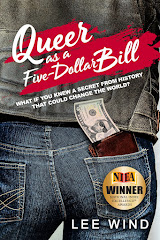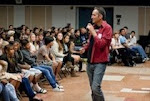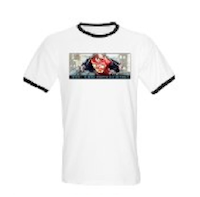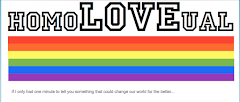AGENTS AND EDITORS NEED TO ADVERTISE THEIR INTEREST IN DIVERSITY
That's the brilliant idea. (And I wish it was mine, but full credit to literary agent Adriana Domínguez (Full Circle Literary), who brought this up in discussion with me and my agent, Danielle Smith (Red Fox Literary) at the LGBTQ Chat at SCBWI's 2014 Summer Conference in Los Angeles.
To achieve more diversity in the world of Children's and Teen literature (a goal so many of us believe in - cue the
#WeNeedDiverseBooks movement), publishing gatekeepers (agents and editors and art directors and publishers) need to do more than just be 'open' to diverse characters and themes, authors and illustrators. They need to get the word out that they are looking for, and want, diverse stories and creators.
This new monthly series is an effort to do just that.
We'll start with agents, because to get more diverse books published, editors need to get more diverse books submitted to them by agents. And to have more diverse books to submit to editors, agents need to see more diversity in the submissions they get from writers and illustrators.
I'll interview each literary agent about their take on and interest in diversity in children's and teen literature, and they'll get to share what they love, what they're looking for, and why diversity in children's and teen literature is important to them.
To start us off, today's post features the agent whose idea sparked this series, Adriana Domínguez of Full Circle Literary.
 |
| Agent Adriana Domínguez |
Here's her bio:
Adriana Dominguez has nearly 20 years of experience in publishing, most recently as Executive Editor at HarperCollins Children's Books, where she managed the children's division of the Latino imprint, Rayo. Prior to that, she was Children's Reviews Editor at Criticas magazine, published by Library Journal. She is a member of the Brooklyn Literary Council that organizes the Brooklyn Book Festival, and one of the founders of the Comadres and Compadres Writers Conference in New York City. Adriana became an agent and joined Full Circle Literary in 2009. She is interested in picture books, middle grade novels, literary young adult novels, and narrative non-fiction. Her client list includes award-winning and best selling authors such as Reyna Grande, Angela Cervantes, Lorena Siminovich, Eric Pierpoint, Michaela & Elaine DePrince, Katheryn Russell-Brown, and Rafael Lopez. Adriana has a long trajectory of publishing underrepresented authors and illustrators, and welcomes submissions that offer diverse points of view.
And our interview...
Lee: Hi Adriana!
Adriana: Hi Lee! It’s always nice to hear from you!
Lee: Thanks so much for agreeing to talk about your interest in Diversity in Children's and Teen Literature!
Adriana: Thank you for inviting me! I am so glad that you are doing this, and honored to learn that I inspired you to create this fabulous new series. I hope that it will help many more diverse writers get published!
Lee: Me, too! There's been growing discussion about how the 5,000 or so traditionally published books a year don't reflect the actual diversity of our world, including the #WeNeedDiverseBooks movement and the
stunningly low numbers of representation revealed in "Children's Books by and about People of Color Published in the United States," put out by the CCBC (The Cooperative Children's Book Center)
To start us off, of the submissions you get, let's say in the past year, how many of those projects included some kind of diversity of characters or theme?
Adriana: I honestly wouldn’t know as I’ve never kept count, but I would guess that the percentage is higher than average, in part due to my publishing trajectory, which has placed me in a variety of positions that have enabled me to promote the work of diverse authors and to help those authors get published. I have a long track record of working with diversity and my submissions reflect that. Over my many years in the industry, I’ve also accumulated a large amount of contacts, and many of those are well aware of my interest in this area, which often results in referrals. And as you point out at the top of this post, I advertise my interest in diversity constantly. I think it’s important to let diverse authors know that you are looking for them, so that when they reach out to you, they feel like they are reaching out to someone who will be receptive to their work. Finally, authors and illustrators who are familiar with our agency’s work and/or visit our website know that we welcome diverse points of view, and find that diversity represented in our client list.
Lee: Let's unpack that a bit: Are you seeing many stories featuring protagonists of color?
Adriana: Absolutely, though I’d like to see even more of them, and more diversity there, too! I have had a good deal of success with Latino and African-American authors and illustrators, and I’d like to think that those groups know that I love to hear from them. I would also like to receive more submissions from Native Americans, Asian Americans, Indian Americans, and everyone else who is still not well represented in children’s books. There is still so much work to do in so many areas!
Lee: How about LGBTQ characters, and please break that down - are you seeing lesbian characters? gay? bi? trans*? questioning? queer or gender non-conforming?
Adriana: Sadly, I am not seeing many LGBTQ characters at all, and I’m not sure why. That disappoints me for a variety of reasons. I’m not so secretly hoping that some of your blog’s followers will consider submitting stories that feature those characters to me after reading this post!
Lee: How about characters with disabilities?
Adriana: A very small number as well, and I would love to see those numbers increase. I think that the recent successes of Wonder and El Deafo have demonstrated that there is a hunger for books that feature characters with disabilities.
Lee: Are you seeing other types of diversity in the works submitted? - And please share any specific categories that spring to mind.
Adriana: None that immediately come to mind, but I will take this question as an opportunity to make what I think is an importation point raised by your other questions above, if you don’t mind: I think that some writers may think that when I say I am interested in “diversity,” I am referring to characters and writers of color only, which could not be farther from the truth. Sometimes it feels like there is still a diversity gap within the diversity category, which is ironic—and I'm sure completely unintentional on everyone’s part. I think that for a long time, so many folks have thought of diversity only in terms of color, that the point that diversity is all-inclusive needs to be consistently highlighted and discussed, as you so wonderfully do here and elsewhere. I assume that this is why the “diversity” I find in my submissions inbox is limited to certain groups, or categories. I wish that weren’t so, because I am so very interested in helping ALL authors get their work read if that work is good, and especially if that work delves into something that we are not seeing enough of.
Lee: How about the creators? Are you seeing under-represented writers and illustrators submitting to you?
Adriana: My responses above apply to both characters and creators.
Lee: There's a lot of discussion about who has the 'right' to tell the story of a under-represented type of character, but I think the question itself needs adjusting. Rather than thinking of telling *THE* story of a type of character (some archetypal tale of THE Gay teen or THE Latina girl or THE Transgendered pre-teen, maybe its better to think of telling *A* character's story - and that character might be Gay, or Latina, or Transgendered. And the more stories we get out there, the less pressure on any one story to 'represent.' I think this is also where the impulse, for authors who aren't part of the under-represented group of the character they're creating, to make their under-represented characters 'perfect' - to sort of avoid the sense that they're criticizing, or falling into stereotypes. But 'perfect' characters are boring, and don't feel very real.
What's your take on who has the 'right' to tell a story?
Adriana: My take on this has always been that the right person to tell any story is the person who writes it well (at least in my admittedly, subjective view). I can think of a number of non-diverse writers who have written diversity well—Laura Resau immediately comes to mind. In most cases, those writers have had enough experience with diversity to write it with confidence, and most importantly, authenticity. I think that the biggest mistake I find authors making when writing diverse characters—a mistake that by the way, can be made by diverse writers as well—is creating two-dimensional characters that feel like they’ve been reduced to stereotypes. What I often advise writers to do to test themselves against this is to remove all of the cultural trappings from their diverse characters to see if there is any trace of that character left. Is there a human being under there? If so, write on! If not, you have not yet given your character life, and the writing needs work. This exercise works with cowboys, spies and any other characters’ aspects too. It works because humans are not archetypes, we are multidimensional beings.
Lee: That's a great tip! When you're submitting projects to editors, do you think stories with under-represented characters take more 'selling' on your part?
Adriana: It truly depends on the project and on the editors I choose for it. Each project is unique. I’ve sold commercial diverse works for six figures at auction, and I’ve sold diverse projects that skew toward the literary to specific editors who place special value on winning certain types of awards. I don’t pigeonhole diversity, which is why I always recommend that writers work with agents who have experience with it, because we understand that diversity comes in many forms. We don’t label authors or their works at our agency, and work hard to make sure that others don’t either. To us, diversity is beautiful icing on a multilayered cake!
Lee: I often feel the sense of ‘otherness’ is transferable. That from my own experiences being marginalized (for being Gay, being ill as a teen, being Jewish, being an Atheist, etc…) I feel tremendous empathy for people who are marginalized for other kinds of ‘otherness’ as well.
Can you share what’s driving your desire to see more diversity in Children’s and Teen books?
Adriana: I wholeheartedly agree that otherness is transferable! I was born in Uruguay and arrived in the United States at the tender age of 12, unable to speak a single word of English. If that doesn’t make me “the other,” I don’t know what does! I can most certainly empathize with those who feel excluded, or unheard. I fell in love with books when I was a kid, but did not find characters like me in novels until I was in college. This is a story that we hear from diverse writers time and time again, and one that I’d personally like to see come to an end. As a teen, I somehow felt “less than” because I couldn’t find my experiences in the media, which had an effect on every aspect of my life at that time. Despite the industry’s challenges, the world of publishing and books once again saved me as an adult by allowing me the extraordinary opportunity to make a difference in the lives of ALL children by, among other things, exposing them to the diversity I could not find and sorely needed at their age. The amount of satisfaction that this gives me is almost impossible to quantify. I have the coolest job in the world!
Lee: Tell us about some books that highlighted or included diversity that you loved and that inspired you (maybe even ones you wish you represented). What’s a Picture Book favorite?
Adriana: Oh Gosh, there are so many! I feel honored to have edited Monica Brown’s Side by Side, The Story of Dolores Huerta and Cesar Chávez because it told a part of American history that had never been told in quite the same way before. I recently read René Colato Laínez’s The Toothfairy Meets El Ratón Perez to my son, which was so much fun to do for the first time! I love how it allows him to play with his different heritages as he learns about each one. I wish there were more books that did that since so many kids these days are biracial/bicultural. Monica Brown’s Marisol McDonald series is the Fancy Nancy for the bicultural generation in my mind! I love the humor in Yuyi Morales’ Niño Wrestles the World, and her amazing Viva Frida. I think that Raúl Colón’s Draw! is stunning. I’m proud to represent Katheryn Russell-Brown’s Little Melba and Her Big Trombone, fabulously illustrated by Frank Morrison. It’s the type of book that I love, where text and art work well together to create something extraordinary. I love all of Kadir Nelson’s work, especially his Heart and Soul: The Story of America and African Americans, which is a masterpiece in every sense of the word. I have so many illustrator favorites, and am excited about some of the ones that we are beginning to hear more from, like Christian Robinson, John Parra and Angela Domínguez. I hope that they will continue to get lots more work because they all deserve it. The lack of diversity in the picture book category is one of my biggest concerns. When we look at the Caldecott, we don’t see much diversity, and not many new names have surfaced in the illustrator category for the targeted awards like the Pura Belpré and the Coretta Scott King in recent years. I’d like to see new names pop up on those lists, and our agency is making great efforts to bring in more author/illustrators of color to the market. I’ve personally signed two incredibly talented ones in the past six months alone.
Lee: Middle Grade?
I have always loved Pam Muñoz Ryan’s modern classic Esperanza Rising. It’s such an honest, engaging book that doesn’t call out the main character’s ethnicity and still manages to connect with so many young Latinas due to its complete authenticity. I am also a big fan of historical fiction, and would love to find a book like Julia Alvarez’s Before We Were Free. Having grown up in a military regime myself, and later become an immigrant in the US, I connected with that book on a very personal and deep level, as I know many others have, too, for a whole host of reasons.
Lee: Young Adult?
Adriana: As I’ve said before, I adore Benjamin Alire Sáenz’s Aristotle and Dante Discover the Secrets of the Universe, and honestly wish I had represented that book! I also love Meg Medina’s Yaqui Delgado Wants to Kick Your Ass because as a Latina who grew up in NY, I know that story well and have no doubt that the book’s existence will be immensely helpful and enlightening to an entire population of high school kids in Queens going through the same things that Medina’s main character experiences.
Lee: Okay, here’s your wish list moment. What are you looking for? Put out the call...
Adriana: I’d really like to find more author/illustrators of color. The industry desperately needs them and I’m a very visual person who loves art. I enjoy my work with artists tremendously.
I adore middle grade and humor, especially when it has heart, and would like to see more fun-filled stories like Tim Federle’s Better Nate Than Never, and Angela Cervantes’ Gaby, Lost and Found, which feature diverse characters, are compelling, and have commercial appeal; that is my personal trifecta!
I love gripping stories like Michaela DePrince’s teen memoir Taking Flight, co-written with her mother, Elaine DePrince, which is one of the most remarkable stories I’ve read in a long while.
I’m a fan of historical fiction and narrative non-fiction for all age groups and am always looking for something innovative and engaging in that area that features some of the characteristics mentioned above.
Like most folks who spend their entire life reading, I enjoy plot twists, and new takes on established genres or story lines. I love to be surprised!
Whether contemporary, historical, funny or dramatic, if your book has heart, you’ve got my attention. If it stays with me long after I’ve put it down, you’ve got my utter devotion. There is nothing that gives me greater pleasure than to help launch an author’s career, or to bring it to the next level, and if that author (or his or her work) is diverse, I'm on a mission from which I won’t be easily detracted!
Lee: And for writers and/or illustrators reading this who feel a resonance with what you’ve shared and who want to submit to you, how should they go about that?
Adriana: They should go to our website and follow our submissions guidelines. As an added bonus, I’d encourage them to mention your blog on the subject line. I’d love to hear from them and would be happy to place those submissions among my top priorities for the new year!
Lee: Anything I didn’t ask that you’d like to add?
Adriana: What I’d like all diverse authors to know about me is that I don’t have a single definition of “diverse literature.” I think that the biographies and works of historical fiction that have hereto dominated the field of diverse writing are immensely important, and as a history buff, I will always be interested in those works if they are done well. However, I would also like to see more works that tackle diversity from a variety of points of view and in a broader array of situations because there is still so much that readers have not been exposed to! The potential to break new ground is one of the aspects that make diverse writing most exciting to me!
I should also note that I don’t represent genre fiction—romance or “beach reads,” paranormal, thrillers, etc.—though I would be willing to look at works that carry some of those elements if they are not strictly genre, and can fall into more than a single category.
Lee: Getting the world of Children’s literature to better reflect the diversity of our world -- the world kids today are growing up in -- is so important. Thank you so much for working to make things better!
Adriana: Ditto! Thank you for all you that you do to keep the conversation going! Good luck with the series!
Thanks, Adriana! What a great start to the series, and to the new year! Look for my next Agent Looking For Diversity Interview on the first Monday of next month.
Illustrate and Write On,
Lee
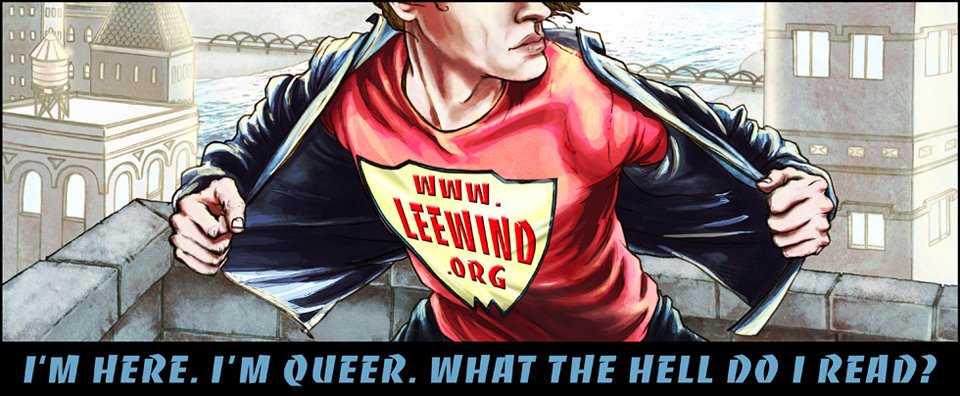960.jpg)

















